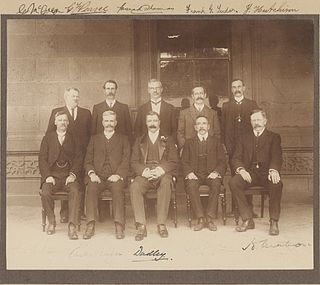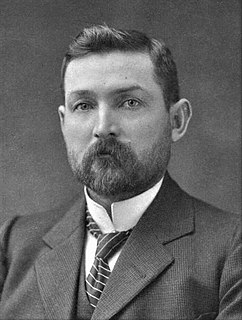
John Christian Watson was an Australian politician who served as the third prime minister of Australia, in office from 27 April to 18 August 1904. He served as the inaugural federal leader of the Australian Labor Party (ALP) from 1901 to 1907 and was the first member of the party to serve as prime minister.
The Free Trade Party which was officially known as the Australian Free Trade and Liberal Association, also referred to as the Revenue Tariff Party in some states, was an Australian political party, formally organised in 1887 in New South Wales, in time for the 1887 colony election, which the party won. It advocated the abolition of protectionism, especially protective tariffs and other restrictions on trade, arguing that this would create greater prosperity for all. However, many members also advocated use of minimal tariffs for government revenue purposes only. Its most prominent leader was George Reid, who led the Reid Government as the fourth Prime Minister of Australia (1904–05). In New South Wales it was succeeded by the Liberal and Reform Association in 1902, and federally by the Anti-Socialist Party in 1906. In 1909, the Anti-Socialist Party merged with the Protectionist Party to form the Commonwealth Liberal Party.
The Protectionist Party or Liberal Protectionist Party was an Australian political party, formally organised from 1887 until 1909, with policies centred on protectionism. The party advocated protective tariffs, arguing it would allow Australian industry to grow and provide employment. It had its greatest strength in Victoria and in the rural areas of New South Wales. Its most prominent leaders were Sir Edmund Barton and Alfred Deakin, who were the first and second prime ministers of Australia.
The Liberal Party was a parliamentary party in Australian federal politics between 1909 and 1917. The party was founded under Alfred Deakin's leadership as a merger of the Protectionist Party and Anti-Socialist Party, an event known as the Fusion.
The First Deakin ministry (Protectionist) was the 2nd ministry of the Government of Australia. It was led by the country's 2nd Prime Minister, Alfred Deakin. The First Deakin ministry succeeded the Barton ministry, which dissolved on 24 September 1903 following Sir Edmund Barton's retirement from Parliament to enter the inaugural High Court. The ministry was replaced by the Watson ministry on 27 April 1904 after the Labour Party withdrew their support over the Conciliation and Arbitration Bill.

The Watson ministry (Labour) was the 3rd ministry of the Government of Australia, and the first national Labour government formed in the world. It was led by the country's 3rd Prime Minister, Chris Watson. The Watson ministry succeeded the First Deakin ministry, which dissolved on 27 April 1904 after Labour withdrew their support and Alfred Deakin was forced to resign. The ministry was replaced by the Reid ministry on 17 August 1904 after the Protectionist Party withdrew their support over the Conciliation and Arbitration Bill.

The Reid ministry was the 4th ministry of the Government of Australia. It was led by the country's 4th Prime Minister, George Reid. The Reid ministry succeeded the Watson ministry, which dissolved on 17 August 1904 after the Protectionist Party withdrew their support and Chris Watson was forced to resign. Due to having to rely on the Protectionists to retain office, half of the ministry was forced to accommodate conservative Protectionists - leading to the government to sometimes be referred to as the Reid-McLean Ministry. The ministry was replaced by the Second Deakin ministry on 5 July 1905 after the Protectionists withdrew their support and returned to office with the support of the Labour Party.

The Third Deakin ministry (Liberal) was the 7th ministry of the Government of Australia. It was led by the country's 2nd Prime Minister, Alfred Deakin. The Fourth Deakin ministry succeeded the First Fisher ministry, which dissolved on 2 June 1909 after the Protectionist Party and the Anti-Socialist Party merged into the Liberal Party "fusion" and withdrew their support in order to form what became the first majority government in federal Australian history. The ministry was replaced by the Second Fisher ministry on 29 April 1910 following the federal election that took place on 13 April which saw the Labour Party defeat the Liberals.

The First Fisher ministry (Labour) was the 6th ministry of the Government of Australia. It was led by the country's 5th Prime Minister, Andrew Fisher. The First Fisher ministry succeeded the Second Deakin ministry, which dissolved on 13 November 1908 after Labour withdrew their support and Alfred Deakin was forced to resign. The ministry was replaced by the Third Deakin ministry on 2 June 1909 after the Protectionist Party and the Anti-Socialist Party merged into the Liberal Party "fusion" and withdrew their support in order to form what became the first majority government in federal Australian history.

Sir William John Lyne KCMG was an Australian politician who served as Premier of New South Wales from 1899 to 1901, and later as a federal cabinet minister under Edmund Barton and Alfred Deakin. He is best known as the subject of the so called "Hopetoun Blunder", unexpectedly being asked to serve as the first Prime Minister of Australia but proving unable to form a government.

Sir George Turner was an Australian politician. He served two terms as Premier of Victoria, holding office from 1894 to 1899 and 1900 to 1901 as a liberal. After Federation he was invited by Edmund Barton to join the inaugural federal ministry, becoming the first Treasurer of Australia. He held office until 1904 under Barton and Alfred Deakin, then a few months later resumed office under George Reid. The government fell in 1905 and Turner retired from politics at the 1906 election.

Allan McLean was an Australian politician who served as the 19th Premier of Victoria, in office from 1899 to 1900. He was later elected to federal parliament, where he served as a government minister under George Reid.

The 1901 Australian federal election for the inaugural Parliament of Australia was held in Australia on Friday 29 March and Saturday 30 March 1901. The elections followed Federation and the establishment of the Commonwealth of Australia on 1 January 1901. All 75 seats in the Australian House of Representatives, six of which were uncontested, as well as all 36 seats in the Australian Senate, were up for election.

The 1903 Australian federal election was held in Australia on 16 December 1903. All 75 seats in the House of Representatives, and 19 of the 36 seats in the Senate were up for election. The incumbent Protectionist Party minority government led by Prime Minister Alfred Deakin retained the most House of Representatives seats of the three parties and retained government with the parliamentary support of the Labour Party led by Chris Watson. The Free Trade Party led by George Reid remained in opposition.

The 1906 Australian federal election was held in Australia on 12 December 1906. All 75 seats in the House of Representatives, and 18 of the 36 seats in the Senate were up for election. The incumbent Protectionist Party minority government led by Prime Minister Alfred Deakin retained government, despite winning the fewest House of Representatives votes and seats of the three parties. Parliamentary support was provided by the Labour Party led by Chris Watson, while the Anti-Socialist Party, led by George Reid, remained in opposition.

The Commonwealth Conciliation and Arbitration Act 1904 was a law passed by the Parliament of Australia and received assent on 15 December 1904. The Act sought to introduced the rule of law in industrial relations in Australia and, besides other things, established the Commonwealth Court of Conciliation and Arbitration.

The first Deakin Government was the second federal executive government of the Commonwealth of Australia. It was led by Prime Minister Alfred Deakin, from 24 September 1903 until 27 April 1904. Deakin was the second Prime Minister of Australia, but served as Prime Minister again from 1905–1908 and 1909–1910 – see Second Deakin Government and Third Deakin Government.

The Watson government was the third federal executive government of the Commonwealth of Australia. It was led by Prime Minister Chris Watson of the Australian Labor Party from 27 April 1904 to 18 August 1904. The Watson government was the first Labor Party national government in both Australia and in the world. Watson was aged just 37 when he became Prime Minister of Australia, and remains the youngest person to have held the post.

The Reid Government refers to the period of federal executive government of Australia led by Prime Minister George Reid. It lasted from 18 August 1904 - 5 July 1905. Reid was the sole Prime Minister of Australia to belong to the Free Trade Party. Allan McLean of the Protectionist Party served as deputy.

The Deakin government (1905–1908) refers to the period of federal executive government of Australia led by Prime Minister Alfred Deakin. It lasted from 5 July 1905 to 13 November 1908. Deakin was the second prime minister of Australia, having previously led the Deakin government (1903–1904), and held the office again in 1909–1910.





























